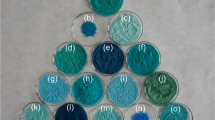Abstract
Egyptian Blue, a multicomponent synthetic blue pigment has been recorded in ancient Egypt since the Fourth Dynasty of the Old Kingdom (2600–2480 B.C.). The pigment consisting of cuprorivaite (CaCuSi4O10) with variable amounts of wollastonite (CaSiO3), Cu-rich glass and cuprite (Cu3O) or tenorite (CuO) was prepared by melting the copper-rich ingredient with lime and desert sand. Low melting temperatures (below 742 °C) were achieved by addition of flux-like plant ashes. The high quality of the pigments collected from monuments of the Fifth Dynasty (2480–2320 B.C.) may indicate that the first manufacture was in early dynastic or perhaps predynastic eras. During the reign of Thutmosis III (18th Dynasty, 1490–1436 B.C.) probably bronze filings were first applied as starting material, thus indicating a technological innovation. This new method was employed till the Roman times.
Similar content being viewed by others
References
Abdel Razek, M., et al: Altägyptische Farbpigmente (in preparation)
Bayer, G., Wiedeman, H.G.: Sandoz Bull. 40, 20 (1976)
Bezborodov, M.A.: Chemie und Technologie der antiken und mittelalterlichen Gläser. Mainz: von Zabern 1975
Chaptal, M.: Ann. Chim. 70, 22 (1809)
Davy, H.: Phil. Trans. 105, 97 (1815)
Fouqué, F.: C.R. Hebd. Séances Acad. Sci. 108, 325 (1889)
Jaksch, H., Weiner, K.L., El Goresy, A.: Fortschr. Miner. (in press)
Jaksch, H.: Dissertation Heidelberg (in preparation)
Kullerud, G., Yoder, H.S.: Econ. Geol. 54, 533 (1959)
Laurie, A.P., McLintoc, W.F.P., Miles, F.D.: Proc. R. Soc. London 89, 418 (1914)
Lucas, A., Harris, J.R.: Ancient Egyptian Materials and Industries. London: Arnold 1962
Minguzzi, C.: Periodico Mineral. 4, 333 (1938)
Noll, W., Hangst, K.: N. Jahrb. Miner. Mh. 1975, 529
Noll, W.: Fortschr. Miner. 57, 203 (1979)
Noll, W.: N. Jahrb. Miner. Mh. 1981, 416
Riederer, J.: Archaeometry 16, 102 (1974)
Saleh, S.A., et al., in: Recent Advances in Sciences and Technology of Materials 3, p. 141. New York: Plenum Press 1974
Theophrastus: De lapidibus (passim)
Ullrich, D.: Diplomarbeit FU Berlin 1979
Vitruvius: De architectura libri decem, Buch VII, Kap. 11, 181 (ed. Fensterbusch). Darmstadt: Wiss. Buchges. 1981
Author information
Authors and Affiliations
Additional information
We should like to express our gratitude to the Stiftung Volkswagenwerk for the financial support without which this study would have not been possible. We are grateful to the Egyptian Antiquities Organization, its former Director, Dr. Abdel Kader Selim, and its present Chairman, Dr. Ahmed Kadry, for the continuous support and permission to collect samples from many sites in Egypt. The authors are grateful to Dr. E. Feucht, H. Guksch (Heidelberg), Prof. W. Kaiser (DAI-Cairo) and Dr. M. Saleh, Director of the Egyptian Museum in Cairo for their egyptological support given during the last two field campaigns. Specifically, Dr. Feucht helped selecting the tombs and temples to be sampled and participated in the 1982 spring campaign. We are especially indebted to Dr. Mahmoud Abdel Razek, Director of the Egyptian Antiquities (Cairo) for his interest, support, assistance, and patience. Discussions with him have helped in understanding many archaeological problems. J. Janicke, who participated in two campaigns, took care of the sample documentation in the field and in laboratory experiments. The help of the local inspectors of the Egyptian Antiquities Organization was a prerequisite for successful field campaigns. H. Urmitzer is thanked for her careful editing of the manuscript. The authors are also grateful to W. Titze for his excellent maintenance of the cars during the fieldtrip 1982. His help in collecting samples is also acknowledged.
Rights and permissions
About this article
Cite this article
Jaksch, H., Seipel, W., Weiner, K.L. et al. Egyptian blue — Cuprorivaite a window to ancient Egyptian technology. Naturwissenschaften 70, 525–535 (1983). https://doi.org/10.1007/BF00376668
Received:
Issue Date:
DOI: https://doi.org/10.1007/BF00376668




